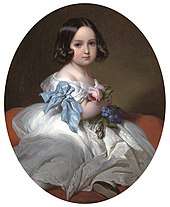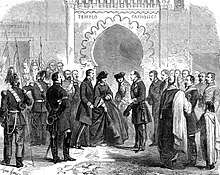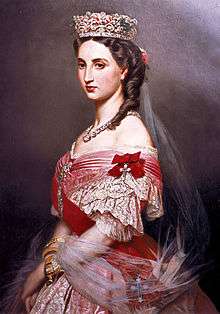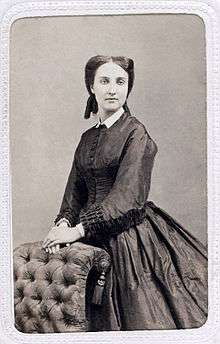Carlota of Mexico
Charlotte of Belgium (7 June 1840 – 19 January 1927) was a Belgian princess who became Empress of Mexico when her husband accepted the Imperial Throne of Mexico and reigned as Maximilian I of Mexico.
| Charlotte of Mexico | |||||
|---|---|---|---|---|---|
 Empress Carlota in 1864. | |||||
| Empress consort of Mexico | |||||
| Tenure | 10 April 1864 – 19 June 1867 | ||||
| Born | 7 June 1840 Laeken, Brussels, Belgium | ||||
| Died | 19 January 1927 (aged 86) Meise, Belgium | ||||
| Burial | |||||
| Spouse | |||||
| |||||
| House | Saxe-Coburg and Gotha | ||||
| Father | Leopold I of Belgium | ||||
| Mother | Louise of Orléans | ||||
| Religion | Roman Catholicism | ||||
Childhood

The only daughter of King Leopold I of Belgium and Louise of Orléans, Charlotte was born at the Royal Castle of Laeken, Belgium. She was named after her father's first wife, Princess Charlotte of Wales. Charlotte had three brothers: Louis-Philippe, who died in infancy; the future Leopold II of Belgium; and Prince Philippe, Count of Flanders. She was close to her maternal grandmother, Maria Amalia of the Two Sicilies, Queen of France, and the two regularly corresponded.
When Charlotte was ten years old, her mother, Queen Louise-Marie, died of tuberculosis and Charlotte was entrusted to the Countess of Hulst, a close family friend. Although young, the princess had her own household; but for a few weeks out of the year, Charlotte stayed in Claremont with Maria Amalia and the rest of her mother's family in exile.
It was rumoured that, in 1866, Charlotte was having an affair with Belgian officer Colonel Alfred Van der Smissen and that she gave birth to a son, Maxime Weygand, in Brussels on 21 January 1867. Weygand refused to confirm or deny the persistent rumor and his parentage remains uncertain. Weygand was a French military commander in both World Wars I and II.[1]
Marriage

In her youth, Charlotte resembled her mother, and was noted to be a beauty, possessing delicate features. Combined with her status as the only daughter of King Leopold, she was a desirable bride. On July 27, 1857, Charlotte married her second cousin Archduke Maximilian of Austria in Brussels, the idealistic younger brother of Emperor Franz Joseph I of Austria. Napoleon III gave Charlotte and her husband Maximilian a beautiful bisque bust of Charlotte as a wedding gift. In the Court of Vienna she was much prized by her mother-in-law, Princess Sophie, who saw in her the perfect example of a wife to an Austrian Archduke. This contributed to the strained relationship between Charlotte and Empress Elisabeth of Austria, wife of Franz Joseph, whom Sophie treated rather cruelly. It is said that Charlotte disliked the deep connection that existed between Elisabeth and Maximilian, who were confidantes and shared the same tastes for many things, especially because her sister-in-law was universally admired for her beauty and charms.
Charlotte spent several relatively happy years in Italy as Maximilian's wife while the archduke served as the governor of the Austrian provinces of Lombardy and Venetia. The position was purely nominal, as power rested in the hand of the Emperor and his officers.
With the loss of Lombardy to the Kingdom of Piedmont in 1859, the unemployed Maximillian and Charlotte began the construction of the castle of Miramare, on the Adriatic coast near Trieste. Charlotte played a major part in planning the layout and statuary of the extensive gardens, while contributing some of her own paintings to the gallery of the palace.[2]
Empress of Mexico

In the early 1860s, the ambitious Napoleon III initiated the French intervention in Mexico. France, eager to turn Mexico into a satellite state, searched for a suitable figurehead to serve as the nominal emperor of Mexico. His choice was Maximilian, who held no real power in Italy and was eager for a more challenging role. Against his brother's advice, Maximilian accepted the Mexican crown and the couple sailed for the New World. The imperial couple were crowned at the Catedral Metropolitana in 1864 and chose as their seat Mexico City, making their home in the Neoclassical Chapultepec Castle. In Mexico, she was known as Carlota.
Life in Mexico
Carlota tried to take her imperial duties seriously and even undertook a tour of the remote Yucatán frontier in November of 1865, visiting the ruins of Uxmal. While there she wrote a series of letters and reports on the peninsula that are now archived in the National Archives of Austria and the Library of Congress.[3] Carlota and Maximilian had no children, but in 1865 the imperial couple adopted Agustín de Iturbide y Green and Salvador de Iturbide y de Marzán—grandsons of Agustín de Iturbide y Arámburu, an earlier emperor of Mexico (r. 1822–23). They gave two-year-old Agustín the title of "His Highness, The Prince of Iturbide"—similar imperial titles were accorded to various members of the child's extended family—but never intended to give him the throne, because he was not of royal blood.[4] Maximilian explained himself that it was all a charade to get his brother Archduke Karl Ludwig of Austria to give him one of his sons as heir.[4]
Only months after the coronation, however, Napoleon III began signaling his abandonment of Maximilian, and the French began to withdraw their troops from Mexico. This strategic pullback was a potentially fatal blow to the infant Mexican monarchy. The situation was exacerbated by a United States blockade that prevented French reinforcements from landing. In a desperate attempt to save her husband's throne, Carlota set sail for Europe from the port of Veracruz upon the transatlantic ocean liner Empress Eugénie on July 13, 1866, determined to persuade Napeoleon III to reverse his decision to withdraw French troops. To help legitimize her visit she was accompanied by M. Martin Castillo, Minister of Foreign Affairs.
Mission in Europe

Carlota arrived in France at the harbor of Saint-Nazaire on August 8 and was greeted by Juan Almonte and his wife. From there Carlota took a train and arrived in Paris on August 9—on the way she had received a telegraph from Napoleon III, informing her that he was terribly ill, but this did little to dissuade her. She stayed at the Le Grand Hôtel and upon arriving was greeted by Napoleon III's wife, Eugénie de Montijo, hoping to deter the determined empress. But again, Carlota could not be dissuaded and Eugénie came to arrange the first of three meetings between the two of them.
Carlota gave long impassioned speeches, reminding Napoleon III of his promises and the Treaty of Miramar. But he and his ministers were unwavering in their position, viewing the Mexican Empire as a lost cause and feeling there were greater concerns on the home front with Prussia. With her efforts all falling to ruin Carlota began manifesting symptoms of paranoia and suffered a profound cognitive and emotional collapse. The first signs of this could be seen with her second meeting with Napoleon, where she became overwhelmed by sadness and threw herself into a nearby armchair, sobbing hysterically. On August 19 in Le Grand Hôtel, Napoleon III met Carlota for the third and final time, declaring with finality his decision to cease providing aid and encouraged her to have Maximilian abdicate the throne.
On August 21, Carlota left for Miramare, Maximilian's castle near Trieste, Italy. On the journey there, Carlota's mental health showed signs of worsening—passing by a farmer, she became convinced that it was an assassin after her and persistently shouted at her coachman to drive faster. Once at Miramare she found a message from Maximilian waiting for her, imploring Carlota to seek an audience with Pope Pius IX in Rome. On the way to Rome she showed further signs of deteriorating mental health; while stopping for the night at the city of Bolzano, Italy, Carlota informed Martin Castillo that she felt unwell and insisted that it was due to being poisoned by spies and traitors of Napoleon III among them.
Carlota finally had her audience with Pope Pius IX on September 27, but he was reluctant to use his influence to intervene with Napoleon III on her empire's behalf. She became despondent and distant thereafter, overwhelmed by despair and paranoia, and remained within her hotel for the next two days. She had begun to deny herself food and water, fearful that someone was out to poison her. On October 1, Carlota went to the Vatican to meet with the Pope, dressed in clothes of mourning, her face reportedly displaying sunken eyes and flushed cheeks. Crying hysterically, she begged to be sheltered for the night out of fear of assassins sent by Napoleon waiting outside, refusing to leave the premises even if it meant having to sleep on the stone floor. The pope conceded to her request and had a bed moved into the library for her, making her one of the few women to ever stay overnight in the Vatican. Carlota spent most of that night writing her will and farewell letters. The following days Carlota confined herself to her hotel room, leaving only on occasion to drink public water from the fountains in Rome with a goblet she had stolen from the Pope's apartment.[5]
When her family eventually became informed of her activities they were shocked and King Leopold sent the count of Flanders to Italy to visit his sister. The Empress, who was very depressed and unstable, took her court to Miramare on advice of her brother the Count of Flanders.[5] Dr. Riedel, Director of the Lunatic Asylum of Vienna visited her, to report the Emperor.
Widowhood

While the Empress was resting, the Emperor of Austria and the King of Belgium sent delegations to Miramare Castle. The Count of Bombelles,[5] and Dr Von Jilek, a friend of the Emperor of Mexico, were sent to Miramare.[5] The King of Belgium sent baron Auguste Goffinet on a mission to get his sister home. Emperor Maximilian was captured by Mexican Republican forces and executed on 19 June 1867. Now archduchess again, she was obedient to the Austrian court, and Count Karl of Bombelles tried to keep her in Miramare. Discussions between the imperial court and Brussels became more important, because of the heritage. The emperor placed Charlotte under custody of his brother Archduke Karl Ludwig of Austria. The king sent his wife to Vienna to visit her cousin Emperor Franz-Josef and take care of Charlotte.
Charlotte was kept under observation by a team of medical and imperial guards. The king sent Jan Frans Bulckens (1813–1876)[5], a Belgian psychiatrist, to his sister.[5] The medical team decided that the empress could not be told of the execution of her husband. With medical approval, Queen Marie Henriette gave her sister-in-law a faked telegram from her husband to come back to Brussels. This worked and the empress-dowager left Miramare for the last time. Together with her sister-in law, Queen Marie Henriette and the Belgian delegation they left for Belgium. After she left Miramare she was returned to the Imperial Court.
Historians think that after the death of the Emperor in Mexico, Charlotte only had the status of a rich dowager. For the Viennese court and imperial family it was in their financial interest to keep her in Miramare. There her fortune was guarded under the care of Eduard von Radonetz, the prefect of Miramare (Trieste). When she was in Belgium the Viennese court would need to pay her dowry to Leopold in Belgium. This theory is confirmed by André Castelot.[6]
Charlotte and her sister-in-law were allowed to go back to Belgium where the king gave her court at Bouchout Castle in Meise, Belgium. During the final years of his life the king cared for his sister. The former empress wrote notes of profound gratitude of the care she received from her brother and nephews.[7] During World War I, there was fighting near Bouchout Castle. The occupying German army did not, however, enter the grounds, over which an Austro-Hungarian flag flew;[8] because Austria-Hungary was one of Germany's chief allies and Carlota was the widowed sister-in-law of the Austrian emperor. As Carlota's illness progressed, her paranoia faded. She remained deeply in love with her husband. After his death, she cherished all of the surviving possessions they had enjoyed in common. Carlota died of pneumonia brought on by influenza at Bouchout Castle on 19 January 1927, and is buried in the Royal Crypt of the Church of Our Lady of Laeken.
Honours
Carlota of Mexico received the following honours:[9]
.svg.png)
- Grand Mistress and Dame Grand Cross of the Imperial Order of San Carlos for Noble Ladies
- Dame Grand Cross of the Order of the Mexican Eagle
- Dame Grand Cross of the Order of Guadalupe

.svg.png)
.svg.png)
.svg.png)
In popular culture
- Medea de Novara portrayed Empress Carlota in the films Juárez y Maximiliano (1934), La paloma (1937), The Mad Empress (1939) and Caballería del imperio (1942), all directed by de Novara's husband, director Miguel Contreras Torres.[12]
- Bette Davis portrayed Empress Carlota in the film Juarez (1939), directed by William Dieterle.[13]
- Carlota is referenced in the first season of The Dick Van Dyke Show in an episode titled "Empress Carlotta's Necklace" (1961).
- María Rivas portrayed the Empress in the historical telenovela Maximiliano y Carlota (1965), directed by Ernesto Alonso.[14]
- Christine Wodetzky portrayed Empress Carlota in the TV miniseries Maximilian von Mexiko (1970).[15]
- Nelly Meden portrayed Empress Carlota in another historical telenovela, El carruaje (1972).
- Helena Rojo portrayed the Empress in the film Those Years (Spanish: Aquellos años, 1973).[16]
- News from the Empire (Spanish: Noticias del Imperio, 1986), a novel by Fernando del Paso, shows a literary portrait of the Empress and her madness.
- Laura Flores also portrayed the Empress in a historical telenovela, The Flight of the Eagle (Spanish: El vuelo del águila, 1994-1995), which was also directed by Ernesto Alonso.
- Marisol Santacruz portrayed Empress Carlota in an episode of the Mexican documentary television series Secretos de nuestra historia (2006), which features "virtual interviews" with historical figures of Mexico.[17][18]
- Federica De Cola portrayed Empress Carlota in the TV miniseries Sisi (2009).[19]
- The musical Carlota: A Serpentine Crown (2009), by composer and scenarist Marcel Wick, portrays Carlota as a woman driven by ambition towards inevitable disaster.
- The novel Carlota: The Empress Who Went Mad with Love (Spanish: Carlota: La Emperatriz Que Enloquecio de Amor, 2017), by Laura Martínez-Belli.
- Is the central character of Adiós Mamá Carlota (2019), a historical play written by Luis Valdez that premiered at the San Jose Stage Company.
- The American film production company Two M Films has announced a project entitled Bringing Back Charlotte. The company gained exclusive access to the archives of the Belgian royal palace, and were allowed to read the letters the empress had written to her father and brothers, while being in Mexico. Belgian born writer/director Maxime Brulein is said to direct the film, for which he wrote the screenplay.[20]
See also
References
- Haslip, Joan (1971). The Crown of Mexico. ISBN 0-03-086572-7.
- McAllen, M. M. (April 2015). Maximilian and Carlota. Europe's Last Empire in Mexico. p. 33. ISBN 978-1-59534-263-8.
- de Bélgica, Carlota (2011). Viaje a Yucatan [Trip to Yucatan] (in Spanish) (1st ed.). México: Conaculta. ISBN 978-607-455-680-3.
- Villalpando, José Manuel; Rosas, Alejandro (2011). Presidentes de México. Grupo Planeta Spain. n.p. ISBN 9786070707582.
- De terugkeer van Charlotte Paperback. Juli 1867 – een delicate opdracht voor baron Adrien Goffinet, Université de Genève
- Maximilien et Charlotte du Mexique : La tragédie de l'ambition
- G. FREDDY, Léopold II intime, Parijs, 1905
- McAllen, M. M. (April 2015). Maximilian and Carlota. Europe's Last Empire in Mexico. p. 408. ISBN 978-1-59534-263-8.
- Hof- und Staatshandbuch der Österreichisch-Ungarischen Monarchie (1866), Genealogy p. 2
- Bragança, Jose Vicente de (2014). "Agraciamentos Portugueses Aos Príncipes da Casa Saxe-Coburgo-Gota" [Portuguese Honours awarded to Princes of the House of Saxe-Coburg and Gotha]. Pro Phalaris (in Portuguese). 9–10: 10. Retrieved 28 November 2019.
- Real orden de Damas Nobles de la Reina Maria Luisa. Guía Oficial de España. 1900. p. 183. Retrieved 21 March 2019.
- "Medea de Novara". Internet Movie Database. Retrieved 27 January 2015.
- "Bette Davis Is Empress In 'Juarez'". The Register-Guard. Retrieved 27 January 2015.
- "Telenovela Carlota y Maximiliano (1965)". YouTube. Retrieved 27 January 2015.
- "Maximilian von Mexiko". Internet Movie Database. Retrieved 19 November 2019.
- "Aquellos años". Internet Movie Database. Retrieved 19 November 2019.
- "1/2 Entrevista Virtual, Emperatriz Carlota de México (Charlotte de Belgique)". YouTube. Retrieved 27 January 2015.
- "2/2 Entrevista Virtual, Emperatriz Carlota de México (Charlotte de Belgique)". YouTube. Retrieved 27 January 2015.
- "Sisi". Internet Movie Database. Retrieved 18 November 2019.
- "Charlotte de Belgique à Hollywood". Cinetelerevue.be. 22 January 2014. Retrieved 1 February 2014.
Further reading
- Prince Michael of Greece (1998). The Empress of Farewells: The Story of Charlotte, Empress of Mexico. New York..
- André Bénit, Charlotte, Princesse de Belgique et Impératrice du Mexique (1840-1927). Un conte de fées qui tourne au délire, Historic'one, Plougastel, 2017ISBN 978-2-91299-462-2.
- André Bénit, « Charlotte de Belgique, impératrice du Mexique. Une plongée dans les ténèbres de la folie. Essai de reconstitution fictionnelle », Mises en littérature de la folie, Çédille, Revista de estudios franceses, Monografías de Çédille 7, 2017, p. 13-54 ISSN 1699-4949.
- André Bénit, Légendes, intrigues et médisances autour des « archidupes ». Charlotte de Saxe-Cobourg-Gotha, princesse de Belgique / Maximilien de Habsbourg, archiduc d’Autriche. Récits historique et fictionnel, Peter Lang, Bruxelles, 2020. 438p. ISBN 978-2-8076-1470-3 |[1].
- del Paso, Fernando (1987). Noticias del Imperio. México. ISBN 9681318110.
- Bibesco, Princesse Marthe (1962). Charlotte et Maximilien. Paris.
- Castelot, André (1985). Maximiliano y Carlota. La Tragedia de la Ambición. México.
- Corti, Conte Egon Caesar (1924). Maximilian und Charlotte von Mexiko. Nach dem bisher unveröffentlichten Geheimarchive des Kaisers Maximilian und sonstigen unbekannten Quellen. 2 vols. Zurich, Leipzig, Viena.
- Corti, Conte Egon Caesar (1953). Maximilian von Mexiko. Die Tragödie eines Kaisers. Francfort del Meno.
- Desternes, Suzanne; Chandet, Henriette (1964). Maximilien et Charlotte. Paris.
- Gómez Tepexicuapan, Amparo (2001). Igler, Susanne; Spiller, Roland (eds.). Carlota en México. Más nuevas del imperio. Francfort del Meno: Estudios interdisciplinarios acerca de Carlota de México. pp. 27–40.
- Miguel de Grecia (2000). La Emperatriz del Adiós. El trágico destino del emperador Maximiliano y su mujer Carlota. Barcelona.
- Harding, Bertita (1934). Phantom Crown: The story of Maximilian and Carlota of Mexico. New York.
- Haslip, Joan (1972). The Crown of Mexico: Maximilian and his Empress Carlota (2nd ed.). New York. ISBN 0030865727.
- Hyde, Montgomery H. (1946). Mexican Empire. The history of Maximilian and Carlota of Mexico. London.
- Igler, Susanne (2002). Carlota de México. Mexico.
- ——— (2006). Carlota de México. Grandes Protagonistas de la Historia Mexicana (2nd ed.).
- ——— (2007). De la intrusa infame a la loca del castillo: Carlota de México en la literatura de su 'patria adoptiva'. Frankfurt: Peter Lang.
- Kerckvoorde, Mia (1981). Charlotte: La passion et la fatalité. Paris.
- Maria y Campos, Armando (1944). Carlota de Bélgica: La infortunada Emperatriz de México. México.
- Praviel, Armand (1937). La vida trágica de la emperatriz Carlota. Buenos Aires.
- Ridley, Jasper (2001). Maximilian & Juarez. London: Phoenix Press.
- Vázquez-Lozano, Gustavo (2016). Emperor Maximilian I of Mexico: The Life of the Only European Monarch in Mexico. Cambridge: Charles River Editors.
External links
| Wikimedia Commons has media related to Charlotte of Belgium, Empress of Mexico. |
- Imperial House of Mexico
- Works by or about Carlota of Mexico at Internet Archive
- Newspaper clippings about Carlota of Mexico in the 20th Century Press Archives of the ZBW
Carlota of Mexico Cadet branch of the House of Wettin Born: June 1840 Died: 19 January 1927 | ||
| Mexican royalty | ||
|---|---|---|
| Vacant Title last held by Ana María Huarte |
Empress consort of Mexico 10 April 1864 – 15 May 1867 |
Monarchy abolished |